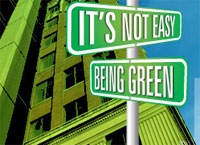While perusing through my classmates’ blogs, I found an entry about Las Vegas posted by Lisa McCann that really sparked my interest. I recently just booked a trip to Las Vegas during the Christmas holidays, and I for sure felt that I was going to the “land of excess” (what would my classmates think of me??!). But to my pleasant surprise, aspects of “green” have been able to make their way to this desert in Neveda.
There is a new addition to the landscape called the Palazzo hotel that has been deemed the largest LEED-certified building in the world. Obviously, we have to leave it to this land of excess to create the largest green building (go big or go home, right?) which is more than 4 times larger than the second largest LEED-certified building.
Some highlights include:
- Artificial turf, drip irrigation and moisture sensors in planted areas result in over a 75% reduction in irrigation needs.
- Swimming pools at The Palazzo are heated with an expansive solar pool heating system. In the summer, the excess solar energy not needed for the pools is directed to the hotel’s hot water system, reducing the need to heat water for guest suites.
- Air conditioning controls in guest suites that automatically setback by several degrees when guests are not present and reset to the desired temperature upon return.
- The building’s structural steel averaged 95% recycled content, while the concrete averaged a 26% recycled content rate.
This is only to name a few aspects of the environmental design. More info can be found in this article: The Palazzo Las Vegas I’ll have to agree with Lisa when she says “Kudos Vegas”. I definitely think this place will change the way people perceive Las Vegas.
I can’t wait to check this place out!



